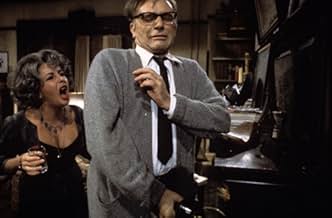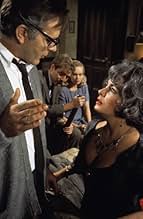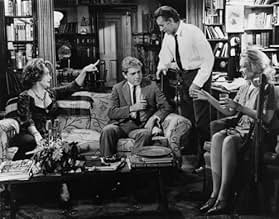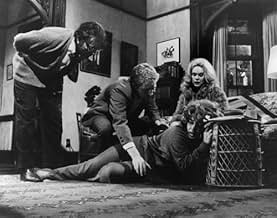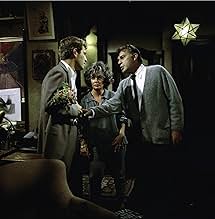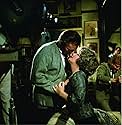A middle-aged New England associate professor and his wife, with the help of alcohol, use their young guests to fuel anguish and emotional pain towards each other over the course of a distre... Read allA middle-aged New England associate professor and his wife, with the help of alcohol, use their young guests to fuel anguish and emotional pain towards each other over the course of a distressing night.A middle-aged New England associate professor and his wife, with the help of alcohol, use their young guests to fuel anguish and emotional pain towards each other over the course of a distressing night.
- Won 5 Oscars
- 22 wins & 26 nominations total
- Director
- Writers
- All cast & crew
- Production, box office & more at IMDbPro
Featured reviews
Simply put, this is one of my favourite films of all time. Great acting, great writing and great camerawork make this close to cinematic perfection. Liz Taylor and Richard Burton give the performances of their lives. Sandy Dennis also shines in an early-ish role. It's a dramatic film, but the wicked humour that permeates the film is absolutely devastating, and I mean that in the best possible way. Many moments in the film I find myself laughing only to think, "Should I be laughing at this." Certainly the film is loaded with uncomfortable moments, enhanced by the camerawork replete with uneasy close-ups. Most of all, this film shows how a lot can be accomplished with just a little: a cast of four and minimal scenery changes. "Who's Afraid Of Virginia Woolf" has become an absolute icon of American cinema. If you haven't seen it, what are you waiting for?
"Who's Afraid of Virginia Woolf?" walks a tightrope between comedy and tragedy. But regardless of the laughter this dark comedy elicits, we can all agree on one unanimous opinion: it's utterly terrifying.
"Terrifying" is a term too light, a shade too gray to stand out amid the dazzling kaleidoscope of emotions within this film.
The story in "Who's Afraid of Virginia Woolf?" unfolds over one night, as one crisis compounds onto another. George and Martha are a middle-aged couple, clearly losing their affection for each other. After a university party, they reluctantly invite another couple, Nick and Honey, to their home. Under the influence of alcohol and the fatigue of the late hour, every conflict, disagreement, and hidden facet of George-Martha and Nick-Honey's marriages gradually unravel in the most damaging ways.
Virginia Woolf was a prolific writer whose style delves deep into the thoughts of each character, exposing the reality of who they are. "Who's afraid of Virginia Woolf?" can be understood as "Who's afraid of living without illusion?" Do you remember Martha's response to George's question at the end of the film? George places his hand on Martha's shoulder and softly sings, "Who's afraid of Virginia Woolf?" Martha replies, "I am, George, I am." It signifies the confrontation between reality and illusion. But who doesn't have moments of fearing reality and escaping into illusions? Yet, the illusion in their minds often remains separate from reality. Unlike Martha and George, who embed illusions into their daily lives too frequently, to the point where Martha believes them to be real. So when she hears news of her son's death, she cries not because her illusion has shattered, but out of pity for that blend of illusion and reality. Her son might have been an illusion, but her suffering was real.
The film's characters feel remarkably authentic as well. They lack the flamboyant personas we often encounter in cinema; they could be anyone, neither entirely virtuous nor inherently wicked, neither deserving of our sympathy nor our ire. They are simultaneously relatable and infuriating, each simply navigating their own slice of life. This authenticity injects a profound sense of realism into the narrative, stripping away any semblance of fiction. While their story may not venture into uncharted territory, the interactions and conflicts between these characters elevate it to new heights, especially the portrayal of Liz Taylor's Martha. Her fiery temperament, piercing voice, seething anger, resentful glances at George, the ceaseless flow of alcohol, the chain of cigarettes, and the tears-all of these elements contribute to the film's atmosphere of stagnation.
The film's gripping intensity can be traced back to its theatrical origins. In the world of theater, we anticipate climaxes, revelations, and resolutions. With each passing moment, tension mounts, growing increasingly oppressive until it reaches a point where we must acknowledge that it cannot be neatly resolved. "Who's Afraid of Virginia Woolf?" transcends the boundaries of mere cinema; it's an unsettling voyage into the delicate equilibrium between illusion and reality. Within its intricate layers, terror and humor seamlessly intertwine, crafting a cinematic experience that leaves an enduring imprint.
"Terrifying" is a term too light, a shade too gray to stand out amid the dazzling kaleidoscope of emotions within this film.
The story in "Who's Afraid of Virginia Woolf?" unfolds over one night, as one crisis compounds onto another. George and Martha are a middle-aged couple, clearly losing their affection for each other. After a university party, they reluctantly invite another couple, Nick and Honey, to their home. Under the influence of alcohol and the fatigue of the late hour, every conflict, disagreement, and hidden facet of George-Martha and Nick-Honey's marriages gradually unravel in the most damaging ways.
Virginia Woolf was a prolific writer whose style delves deep into the thoughts of each character, exposing the reality of who they are. "Who's afraid of Virginia Woolf?" can be understood as "Who's afraid of living without illusion?" Do you remember Martha's response to George's question at the end of the film? George places his hand on Martha's shoulder and softly sings, "Who's afraid of Virginia Woolf?" Martha replies, "I am, George, I am." It signifies the confrontation between reality and illusion. But who doesn't have moments of fearing reality and escaping into illusions? Yet, the illusion in their minds often remains separate from reality. Unlike Martha and George, who embed illusions into their daily lives too frequently, to the point where Martha believes them to be real. So when she hears news of her son's death, she cries not because her illusion has shattered, but out of pity for that blend of illusion and reality. Her son might have been an illusion, but her suffering was real.
The film's characters feel remarkably authentic as well. They lack the flamboyant personas we often encounter in cinema; they could be anyone, neither entirely virtuous nor inherently wicked, neither deserving of our sympathy nor our ire. They are simultaneously relatable and infuriating, each simply navigating their own slice of life. This authenticity injects a profound sense of realism into the narrative, stripping away any semblance of fiction. While their story may not venture into uncharted territory, the interactions and conflicts between these characters elevate it to new heights, especially the portrayal of Liz Taylor's Martha. Her fiery temperament, piercing voice, seething anger, resentful glances at George, the ceaseless flow of alcohol, the chain of cigarettes, and the tears-all of these elements contribute to the film's atmosphere of stagnation.
The film's gripping intensity can be traced back to its theatrical origins. In the world of theater, we anticipate climaxes, revelations, and resolutions. With each passing moment, tension mounts, growing increasingly oppressive until it reaches a point where we must acknowledge that it cannot be neatly resolved. "Who's Afraid of Virginia Woolf?" transcends the boundaries of mere cinema; it's an unsettling voyage into the delicate equilibrium between illusion and reality. Within its intricate layers, terror and humor seamlessly intertwine, crafting a cinematic experience that leaves an enduring imprint.
10Rathko
An undisputed classic that chronicles every appalling moment of a drunken night in hell as middle-aged George and Martha tear each other, and their guest, to pieces.
Elizabeth Taylor proves categorically that she was a truly great actress. Her Oscar-winning performance as the psychologically tormented Martha is one of the greatest performances in the history of cinema. Taylor's imperceptible shifting from sadism to tenderness, from bullying condescension to exhausted vulnerability, is a masterclass in character building. Martha is a truly monstrous character, and yet Taylor is able to imbue her with sympathy, allowing you brief glimpses of the warm and lovable woman she could have been.
Richard Burton is equally magnificent as George; an ageing, failing college professor whose initial meekness gives way to a raging torment all of his own. His verbal sparring with Taylor, like two pit-bulls in the ring of an endless and bloody dogfight, has become legendary. Every word drips with malice and contempt, every sentence is designed to cut the deepest wound. At times, it becomes painful to watch, but like true train-wreck television, you cannot drag yourself away from the inevitably terrible conclusion.
Quite possibly, this is as close to perfect as movies can get; beautifully written dialogue, deeply complex characters, an evolving and suspenseful storyline, beautiful photography, and a wonderfully understated score by Alex North. Nominated for 13 Academy Awards in 1967, but lost out to A Man for All Seasons and Born Free to win only 5.
"Who's Afraid of Virginia Woolf?" "I am."
Elizabeth Taylor proves categorically that she was a truly great actress. Her Oscar-winning performance as the psychologically tormented Martha is one of the greatest performances in the history of cinema. Taylor's imperceptible shifting from sadism to tenderness, from bullying condescension to exhausted vulnerability, is a masterclass in character building. Martha is a truly monstrous character, and yet Taylor is able to imbue her with sympathy, allowing you brief glimpses of the warm and lovable woman she could have been.
Richard Burton is equally magnificent as George; an ageing, failing college professor whose initial meekness gives way to a raging torment all of his own. His verbal sparring with Taylor, like two pit-bulls in the ring of an endless and bloody dogfight, has become legendary. Every word drips with malice and contempt, every sentence is designed to cut the deepest wound. At times, it becomes painful to watch, but like true train-wreck television, you cannot drag yourself away from the inevitably terrible conclusion.
Quite possibly, this is as close to perfect as movies can get; beautifully written dialogue, deeply complex characters, an evolving and suspenseful storyline, beautiful photography, and a wonderfully understated score by Alex North. Nominated for 13 Academy Awards in 1967, but lost out to A Man for All Seasons and Born Free to win only 5.
"Who's Afraid of Virginia Woolf?" "I am."
One only has sympathy for these ultimately dysfunctional characters as they unfold their little "fun and games," like "Down the Host," "Hump the Hostess," and "Get the Guests." If only George and Martha had retired a wee bit earlier none of this would've happened.
Then, too, why didn't Nick and Honey simply leave, rather than stick around for the "full treatment"? Can it be that "like attracts like," so much so that they couldn't leave?
The final denouement suggests that a new day may be in the offing for poor Martha and George, after the latter has "killed off the 'little bugger.' " Although Martha's admittedly still fearful, she clings firmly to George's hand. Perhaps there's some hope, anyway, for this emotionally spent couple.
Edward Albee, taking no small degree of awareness from Tennessee Williams and Harold Pinter, crafted a play that certainly communicated to a goodly number of people.
Personally recalling sitting in its Broadway run, watching Uta Hagen and cast go through their paces, I remember being as impressed with the riotous audience laughter as with the play itself. The raw lines coming from up-to-then very respectable status characters, namely college prof and wife, seemed to provide some kind of early 60s liberation from the staid and repressive 50s.
By the time the film was released in '66, the public was ready for its no-holds-barred dialogue. It ushered in an new era of social upheaval, of which we're still feeling the effects today.
The "boozy battle" between the hosts, hosts and guests, and guests and guests, paralleled the cultural "steam" being released during that politically "hot" period. The American home drastically changed as a nation experienced more domestic squabbles, separations, divorces, custody battles, and family breakdowns--the last including a noted demise of the traditional "family meal."
In Albee's "long night's journey into morning," the audience must endure two hours of fighting, bickering, insulting, and lamenting before any ray of hope is introduced (during its last five minutes). A long time to wait, but there it is: a glimmer that there may be something better ahead. But we're not sure; after all, "Is this fact or fiction, Martha?"
In an extensive GM Quarterly interview, Director Mike Nichols revealed that this was a very troubled production that almost didn't get finished--with a leading cast boozing and pill-dosing even during lunch breaks--stretching the very limits of professionalism.
Yet in the end, Nichols, Cinematographer Haskell Wexler, and Composer Alex North all got what they wanted. A question is, "was it all worth the effort?" That's something only the individual viewer can answer: is this a case of "nothing from nothing leaves nothing?" or "a cathartic and emotionally moving experience?"
Then, too, why didn't Nick and Honey simply leave, rather than stick around for the "full treatment"? Can it be that "like attracts like," so much so that they couldn't leave?
The final denouement suggests that a new day may be in the offing for poor Martha and George, after the latter has "killed off the 'little bugger.' " Although Martha's admittedly still fearful, she clings firmly to George's hand. Perhaps there's some hope, anyway, for this emotionally spent couple.
Edward Albee, taking no small degree of awareness from Tennessee Williams and Harold Pinter, crafted a play that certainly communicated to a goodly number of people.
Personally recalling sitting in its Broadway run, watching Uta Hagen and cast go through their paces, I remember being as impressed with the riotous audience laughter as with the play itself. The raw lines coming from up-to-then very respectable status characters, namely college prof and wife, seemed to provide some kind of early 60s liberation from the staid and repressive 50s.
By the time the film was released in '66, the public was ready for its no-holds-barred dialogue. It ushered in an new era of social upheaval, of which we're still feeling the effects today.
The "boozy battle" between the hosts, hosts and guests, and guests and guests, paralleled the cultural "steam" being released during that politically "hot" period. The American home drastically changed as a nation experienced more domestic squabbles, separations, divorces, custody battles, and family breakdowns--the last including a noted demise of the traditional "family meal."
In Albee's "long night's journey into morning," the audience must endure two hours of fighting, bickering, insulting, and lamenting before any ray of hope is introduced (during its last five minutes). A long time to wait, but there it is: a glimmer that there may be something better ahead. But we're not sure; after all, "Is this fact or fiction, Martha?"
In an extensive GM Quarterly interview, Director Mike Nichols revealed that this was a very troubled production that almost didn't get finished--with a leading cast boozing and pill-dosing even during lunch breaks--stretching the very limits of professionalism.
Yet in the end, Nichols, Cinematographer Haskell Wexler, and Composer Alex North all got what they wanted. A question is, "was it all worth the effort?" That's something only the individual viewer can answer: is this a case of "nothing from nothing leaves nothing?" or "a cathartic and emotionally moving experience?"
Who's afraid of Virgina Wolf? contains what I would call the most outstanding old school actor/audience experience I'ver ever seen. This movie is 131 minutes long and only contains 5 actors, on of which hardly gets any screen time and the two leading characters played by the famous couple Richard Burton and Elizabeth Taylor are on screen almost the whole time. Also this movie only contains a couple of locations so the whole project depends almost entirely on these two actors superb performance. The two of them fight almost the entire movie and it never gets boring for a second. Well, I gave this movie ten stars..... definitely a classic must see if you're interested in acting.
Did you know
- TriviaThis became the first movie in Academy Awards history since Cimarron (1931) to be nominated for every Academy Award category in which it was eligible, including Best Adapted Screenplay (Ernest Lehman), Director (Mike Nichols), all of the acting categories (Richard Burton, Dame Elizabeth Taylor, George Segal and Sandy Dennis) and Picture of the Year (Ernest Lehman).
- GoofsThe four characters stop at a bar after the first soiree at George's house. It is clearly after 2:00 a.m., since the time was stated during the first segment. No bars, however, would have been open after 1 or 2 a.m. in the New England states, where the film is set.
- ConnectionsEdited from La Lettre (1940)
- SoundtracksWho's Afraid of Virginia Woolf?
(to the tune of "Here We Go Round the Mulberry Bush")
Traditional English melody
Original lyrics ("Who's Afraid of the Big Bad Wolf?") by Frank Churchill and Ann Ronell; modified by Edward Albee
Performed by Elizabeth Taylor
Details
- Release date
- Country of origin
- Languages
- Also known as
- ¿Quién le teme a Virginia Woolf?
- Filming locations
- Cambridge, Massachusetts, USA(location)
- Production companies
- See more company credits at IMDbPro
Box office
- Budget
- $7,500,000 (estimated)
- Gross US & Canada
- $28,000,000
- Gross worldwide
- $28,007,258
- Runtime
- 2h 11m(131 min)
- Color
- Sound mix
- Aspect ratio
- 1.85 : 1
Contribute to this page
Suggest an edit or add missing content


